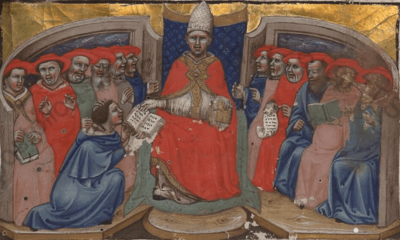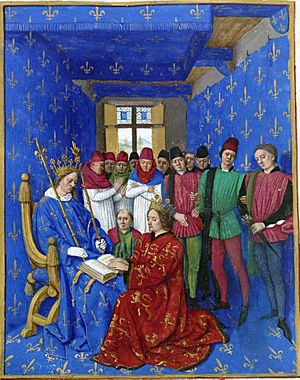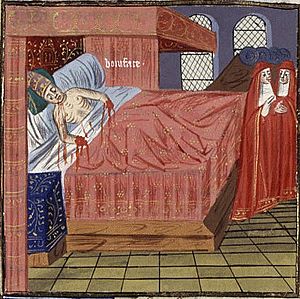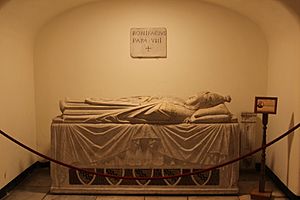Pope Boniface VIII facts for kids
Quick facts for kids Pope Boniface VIII |
|
|---|---|
| Bishop of Rome | |
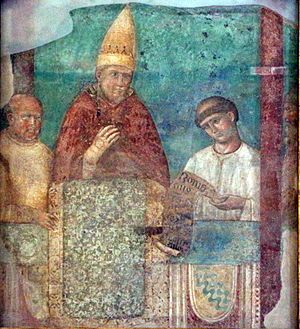
Boniface VIII declaring the Jubilee Year, fresco by Giotto in the Basilica of St. John Lateran
|
|
| Church | Catholic Church |
| Papacy began | 24 December 1294 |
| Papacy ended | 11 October 1303 |
| Predecessor | Celestine V |
| Successor | Benedict XI |
| Orders | |
| Consecration | 23 January 1295 by Hugh Aycelin |
| Created Cardinal | 12 April 1281 |
| Personal details | |
| Birth name | Benedetto Caetani |
| Born | c. 1230 Anagni, Papal States |
| Died | 11 October 1303 (aged 72–73) Rome, Papal States |
| Previous post |
|
| Coat of arms |  |
| Other Popes named Boniface | |
Pope Boniface VIII (born Benedetto Caetani, around 1230 – 11 October 1303) was the leader of the Catholic Church and the ruler of the Papal States from 1294 until his death in 1303. He came from a noble family called the Caetani, who had connections to the papacy. He became pope after Pope Celestine V chose to step down from his role. Boniface spent his early career working as a diplomat in other countries.
Boniface VIII believed that popes should have strong power over both religious matters (spiritual power) and worldly affairs (temporal power), like ruling countries. He often got involved in the politics of France, Sicily, Italy, and even the First War of Scottish Independence. His strong views and constant involvement in worldly issues led to big arguments with leaders like Albert I of Germany and Philip IV of France. The famous writer Dante Alighieri even put Boniface in a bad place in his book Divine Comedy, among those who bought or sold church positions.
Boniface helped organize Church law by creating a new collection called the Liber Sextus in 1298. This book is still important for Church lawyers today. He also started the first Catholic "jubilee" year in Rome, which was a special year of forgiveness and pilgrimage. Boniface first clashed with King Philip IV of France in 1296. Philip wanted to tax the clergy (church officials) and stop them from being involved in legal matters. Boniface responded by excommunicating Philip and anyone who stopped French clergy from traveling to the Holy See (the Pope's authority). In 1303, King Philip sent his soldiers to attack the Pope's home in Anagni and capture him. Boniface was held for three days and was badly treated.
Later, King Philip IV pressured Pope Clement V (who was based in Avignon) to hold a trial for Boniface after his death. However, no final decision was made against him.
Life and Career
Family Background
Benedetto Caetani was born in Anagni, a town about 50 kilometers (31 miles) southeast of Rome. He was a younger son of Roffredo Caetani, who belonged to a noble family from the Papal States.
His mother, Emilia Patrasso di Guarcino, was related to Pope Alexander IV. This connection meant his family was close to important Church leaders and could help him in his career.
Early Steps in the Church
Benedetto began his religious life at a monastery in Velletri. He was looked after by his uncle, Fra Leonardo Patrasso. He was given a position as a canon at the cathedral in his family's hometown of Anagni. The earliest record of him is from 1250. In 1252, he moved to Todi to study law with his uncle Pietro Caetani, who had become the Bishop of Todi.
In 1264, Benedetto started working for the Roman Curia, which is the Pope's administration. He served as a secretary to Cardinal Simon de Brion, who later became Pope Martin IV. He traveled with the Cardinal on a mission to France.
Later, in 1265, Benedetto went to England with Cardinal Ottobono Fieschi. They worked to calm down conflicts after a rebellion against King Henry III. While in England, Benedetto became a rector (a type of priest) at a church in Towcester.
After returning from England, Benedetto continued to rise in the Church. He became a papal Notary in the late 1270s. During this time, he gained many church positions. In 1281, Pope Martin IV made him a cardinal deacon. He was later sent as a papal representative to help solve conflicts in Umbria. In 1291, Pope Nicholas IV promoted him to the rank of Cardinal Priest. As a cardinal, he worked as a papal legate (a papal ambassador) in France, Naples, Sicily, and Aragon.
Becoming Pope

Pope Celestine V decided to step down from his role on December 13, 1294. He had been living like a monk in Naples, which made some cardinals uncomfortable. Benedetto Caetani was one of several cardinals who encouraged Celestine to resign. Church law allowed a pope to resign.
The election for the new pope began on December 23, 1294. All twenty-two cardinals met in Naples. Benedetto Caetani was elected on Christmas Eve, December 24, 1294. He chose the name Boniface VIII. He was officially made Bishop of Rome on January 23, 1295. He immediately moved the papal court back to Rome. One of his first actions was to ensure his predecessor was kept safe in a castle.
In the year 1300, Boniface VIII officially started the tradition of the Roman Jubilee. This event brought many pilgrims and money to the Church. In 1303, Boniface VIII also founded Sapienza University of Rome, a famous university.
Church Law Expert
Boniface VIII had a big impact on Church law. Earlier collections of Church laws were put together in 1234. But over the next 60 years, many new legal decisions were made by different popes. A new, updated version was needed.
In 1298, Boniface ordered a new collection of these papal decisions to be published. This included 88 of his own legal rulings. This collection became known as the Liber Sextus (meaning "Sixth Book"). This book is still very important for Church lawyers today to understand and use Church laws correctly. It includes simple sayings like "No one can be obligated for something impossible."
Dealing with Cardinals
Boniface VIII believed the pope should have strong power over both religious and worldly matters. He often got involved in international politics. In his official letter (called a Papal bull) of 1302, Unam sanctam, Boniface VIII stated that everyone must obey the Roman pontiff (the Pope) to be saved. He said that both spiritual and worldly power were under the Pope's control. These strong beliefs led to many arguments with leaders like Albert I of Germany and Philip IV of France. Dante Alighieri wrote a book called De Monarchia to argue against Boniface's claims of papal power.
In 1297, Cardinal Jacopo Colonna had a dispute with his brothers over land. His brothers appealed to Pope Boniface VIII. Boniface ordered Jacopo to return the land and give some family strongholds to the Papacy. Jacopo refused. Jacopo and his nephew, Pietro Colonna, were also friendly with the Pope's political enemies. In May, Boniface removed them from the group of cardinals and excommunicated them.
The Colonna family claimed that Boniface's election was illegal because Pope Celestine V had resigned. This disagreement led to fighting. By the end of 1298, Boniface's army had captured the Colonna family's towns. The city of Palestrina was completely destroyed, with salt even spread over its ruins. Only the city's cathedral was saved.
To manage the group of cardinals, Boniface appointed new cardinals five times during his time as pope. He mostly appointed Italians, including his own relatives. He also appointed Franciscans but very few Benedictines or French cardinals. This changed the makeup of the cardinals and reduced the influence of the King of France.
Conflicts in Italy
When Frederick III of Sicily became king, Boniface tried to stop him. When Frederick continued, Boniface excommunicated him in 1296. This meant Frederick was cut off from the Church. The conflict continued until 1302, when a peace agreement was reached.
Boniface also put the city of Florence under an interdict (a ban on Church services). He invited Charles, Count of Valois to Italy in 1300 to end a feud between two groups, the Black and White Guelphs. The poet Dante Alighieri belonged to the White Guelphs. Charles's actions allowed the Black Guelphs to take control, and leaders of the White Guelphs, including Dante, were sent into exile. Dante later got back at Boniface in his book Inferno, by placing the pope in a section for those who bought or sold church positions.
Conflicts with Philip IV of France
The conflict between Boniface VIII and King Philip IV of France (1268–1314) happened as countries were becoming stronger and kings wanted more power. Philip wanted to use the wealth of the Catholic Church in France to support his country and pay for wars. He started taxing the clergy.
Boniface saw this as an attack on the Church's rights. In February 1296, he issued a bull called Clericis laicos. This bull forbade lay people (non-clergy) from taxing the clergy without the Pope's permission. It also said that anyone who took Church property would be excommunicated.
Philip fought back by stopping money from leaving France for Rome, which the Church needed. Boniface had to back down a bit. In September 1296, he issued another bull, Ineffabilis amor, which allowed the clergy to make voluntary contributions for the country's defense. Philip then allowed money to be exported again. Boniface even helped settle a dispute between Philip and King Edward I of England, mostly in Philip's favor.
The First Jubilee Year
Boniface declared the year 1300 a "jubilee" year. This was the first of many such special years to happen in Rome. He might have wanted to collect money from pilgrims coming to Rome, or he might have been looking for support against the French king. The event was a huge success. Rome saw huge crowds, with some saying 200,000 pilgrims visited. Boniface and his helpers managed the event well, providing plenty of food at fair prices. The large sums of money collected could be used by the Pope as he saw fit.
Scottish Independence War
After King Edward I of England invaded Scotland, the Scottish King John Balliol was released into the Pope's care. The Scottish Parliament, fighting for independence, asked the Pope to claim authority over Scotland. The Pope agreed and issued a bull called Scimus, Fili in June 1299. This bull ordered Edward to stop his attacks and talk with the Scots. However, Edward ignored the bull. In 1301, the English nobles wrote a letter rejecting the Pope's authority, but it was never sent.
Continued Conflict with Philip IV
The conflict between Boniface and Philip IV grew worse in the early 1300s. Philip started a strong campaign against the Pope. A papal representative, Bernard Saisset, was arrested by Philip's officials in 1301. He was accused of starting a rebellion and convicted by the royal court.
In December 1301, Boniface issued the bull Ausculta Fili ("Listen, My Son"). In it, he told Philip to humbly listen to the Pope, who was the spiritual ruler over all kings. He protested against churchmen being tried in Philip's courts and the use of church money for state purposes. He also announced he would call a meeting of French bishops to protect the Church's freedoms. When this bull was given to Philip, it was reportedly thrown into a fire.
In February 1302, the bull Ausculta Fili was publicly burned in Paris. To stop the Church meeting Boniface planned, Philip called together the three main groups of his kingdom (nobles, clergy, and common people) in April. At this first French Estates-General, all three groups wrote to Rome defending the king and his worldly power. Despite Philip's ban, about 45 French church leaders went to the Pope's meeting in Rome in October 1302.
After that meeting, on November 18, 1302, Boniface issued the bull Unam sanctam. This bull stated that both spiritual and worldly power were under the Pope's control, and that kings were below the power of the Roman pontiff. The Pope also sent another cardinal to Philip to try and find a solution.
Attack and Death
On April 4, 1303, the Pope again excommunicated anyone who stopped French clergy from coming to the Holy See, including King Philip IV, though not by name. In response, Guillaume de Nogaret, Philip's main minister, called Boniface a heretic and a criminal. On August 15, 1303, the Pope took away the King's right to appoint anyone to church positions in France.
On September 7, 1303, an army led by Philip's minister Nogaret and Sciarra Colonna attacked Boniface at his palace in Anagni. The Pope responded with a bull on September 8, excommunicating Philip and Nogaret. The French demanded the Pope step down. Boniface VIII replied that he would "sooner die." In response, Colonna reportedly slapped Boniface. This event is known as the schiaffo di Anagni ("Anagni slap").
Boniface, who was 73 years old, was probably beaten and nearly killed. He was released after three days. He died a month later, on October 11, from a high fever. He was fully aware and surrounded by cardinals and his household.
Burial and Discovery
Boniface VIII was buried in 1303 in a special chapel. His body was accidentally uncovered in 1605. Records from that time describe his body as "unusually tall." His body was found mostly intact, especially his hands. This helped to disprove a rumor that he had died in a rage, biting his hands. His body was dressed in the church clothes of his time, including a cassock, stole, and rings.
After this discovery, Boniface's body was moved. It now rests in the crypt (underground area) of St. Peter's Basilica in a large marble tomb.
Trial After Death
After the papacy moved to Avignon in 1309, Pope Clement V, under great pressure from King Philip IV, agreed to a trial for Boniface after his death. Clement said that anyone who wanted to accuse Boniface could do so.
However, the King of Aragon and the King of Castile immediately complained to Pope Clement. They said it was wrong to accuse a Roman pontiff of heresy, as it made people doubt the Pope's authority in matters of faith. Complaints also came from other countries.
In April 1310, Clement V pardoned Guillaume Nogaret for his actions against Boniface VIII at Anagni. By the end of Spring 1310, Clement was embarrassed by the poor quality of the evidence against Boniface. He ordered that future questioning of witnesses should be done under threat of punishment for lying.
Before a full trial could happen, Clement convinced Philip to let the Council of Vienne decide Boniface's guilt. The Council met in 1311. Three cardinals spoke at the Council, saying that Boniface was a good and moral pope. Two knights even offered to fight anyone who questioned Boniface's innocence. No one accepted the challenge, and the Council closed the matter.
Personality
Boniface was known for having a short temper. It is said that he once kicked an envoy (a messenger) in the face. Another time, he reportedly threw ashes in the eyes of an archbishop who was kneeling to receive a blessing.
In Culture
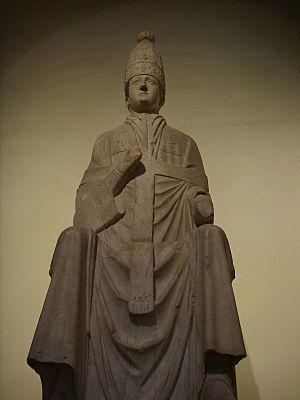
- In his book Inferno, Dante wrote that Boniface VIII was headed for hell, where people who bought or sold church positions are punished. This was written while Boniface was still alive.
- The mathematician and astronomer Campanus of Novara served as a doctor or chaplain to Pope Boniface VIII.
- In Giovanni Boccaccio's book Decameron, Boniface VIII is shown in a funny way, giving a highwayman a church position.
- The story of Pope Boniface is told in John Gower's Confessio Amantis. Gower claims that Boniface tricked Pope Celestine V into stepping down by having a young priest pretend to be the voice of God.
- Boniface was a supporter of the artist Giotto.
- Boniface had many churches in Rome restored for the Great Jubilee of 1300, including St. Peter's Basilica and the Lateran Basilica.
- Pope Boniface VIII is a character played by Jim Carter in the History Channel TV show Knightfall. In the show, Boniface is shown as a kind and wise leader who helps the Knights Templar.
Images for kids
See also
 In Spanish: Bonifacio VIII para niños
In Spanish: Bonifacio VIII para niños
- Giovanni Villani (a writer who described Boniface and his jubilee)
- Unam sanctam
- Barons' Letter of 1301


